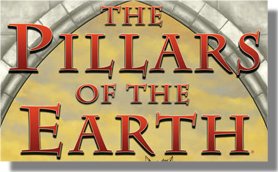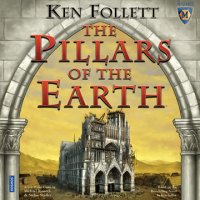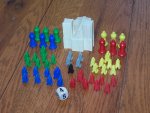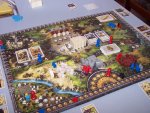
|
Pillars of the Earth A game by Michael Rieneck and Stefan Stadlerr Published by Kosmos Games and distributed in the US by Mayfair Games, Inc. Players: 2-4 Time: 120 minutes Reviewed by Susan Rozmiarek |

|
The Pillars of the Earth is a game based on the bestselling novel by Ken Follett. The game is co-designed by Michael Rieneck and Stefan Stadler and is published by Mayfair Games. Players are master builders in the 12th century working on the construction of a great cathedral in Kingsbridge, England. They try to hire skilled craftsmen as well as workers to collect needed resources as well as deal with numerous problems that can crop up.
Components:
- Game board - this depicts the various locations around Kingsbridge along with a scoring track around the edge. The art is simply stunning and it is easily one of the most beautiful game boards in my collection.
- Many wooden playing pieces in player colors: master builders, workers, and scoring markers
- Wooden cubes in five colors representing the five resources - stone, wood, sand and metal
- Small-sized cards including craftsman cards, resources cards, privilege cards, event cards, and summary cards. The art on these is very nice as well.
- 1 die
- Miscellaneous wooden pieces - gray workers, black worker, and black cost marker
- 1 Storage Bag
- Cathedral pieces - six chunky, white wooden pieces of various shapes that when assembled, form the cathedral
- Rulebook - the rules are well written and in color with many illustrations
Game play:
Players start the game with a number of workers as well as one "big" worker that counts as five workers. They also have three master builders which are put into the cloth bag along with the other players' master builders. In addition, each player starts with three craftsman cards - a mortar mixer, a woodworker, and a stonecutter. The rest of the craftsman cards are sorted into six piles of four cards each, sorting by the numbers on the back of the cards. Each set of four will become available on the appropriate round of the game.
The game board depicts various numbered locations around Kingsbridge. There is a location for each type of the four resources. These are where workers will be placed to gather them. The other locations have a fixed number of spots at each for master builders to be placed. In fact, some even just have one spot to make for some fierce competition. Only players with a master builder at the location will be able to take the action or get the benefit there. Rather than listing the pre-game setup for these locations, they will be explained more fully in the Phase 3 description below.
Each game round has three phases:
Phase 1: Selection of Resource Cards and Craftsmen
At the beginning of each round, two craftsman and seven resource cards are turned over from the deck and in turn order, players can select cards until they are all gone or all players pass. The craftsman each have a cost in gold and the resource cards have a cost in workers that are placed in the appropriate location on the board. Each card also shows how many of that type a resource will be collected. Craftsmen go on the table in front of players (maximum of five, craftsmen can be discarded).
Phase 2: Master Builder Placement
This is where the game gets really interesting. Master builders are drawn randomly one-at-a-time from the bag. When a player's builder is drawn, he must decide whether to place it on the board or pass for now. The kicker is that the first one out of the bag costs seven gold to place, the second costs six and so on. Eventually the cost falls to zero and once all the builders in the bag have been drawn, the players who previously passed get to place those builders for free, starting with the first to pass. Also, the starting player has a little bonus in this phase as he can decide to throw one drawn master back into the bag. Players have to make lots of decisions on the fly during this whole process, depending on when their builders get drawn and how badly they want particular locations on the board balanced with how much money they have or want to spend. A lot of people are going to be quite frustrated with the luck of the draw, enough to perhaps spoil the game for them, but I loved it. I liked the drama of drawing and pushing my luck, hoping for the early free placements. I always felt like I had something to do and if I really needed a certain location on the board, I saved up money to be able to place as soon as one of my builders was drawn. Of course, there is no guarantee as somebody else's could be drawn before me and my coveted spot taken. This actually can be frustrating but as I stated, there is usually something else useful to do in its place.
Phase 3: Game Board Actions
Now each of the 14 locations will be resolved in numerical order. Those familiar with the games Caylus and Leonardo Da Vinci will notice the similarity immediately as those games use a similar mechanism. This phase goes very quickly, as all the decisions have already been made by the players. Perhaps the easiest way to describe this phase is to list and describe each location:
- Events: The top card of the event deck is revealed and resolved immediately. There are both negative and positive events in the deck which can include losing or receiving gold, victory points, or resources.
- Archbishop's office: There is only one spot for a master builder and the player who places here can choose between being protected from the previously drawn event card or taking a single resource of their choice from the market.
- Wool Mill: Master builders are not placed here. Rather, players can place workers here at the end of phase 1. They now receive 1 gold for each worker placed.
- Kingsbridge: Two new privilege cards will be displayed here each round. There is one location under each for a master builder, whose owner will now receive the card. Some of these are immediate effects, like receiving gold, but other have effects for the player, often quite powerful, that remain for the rest of the game. They might allow the player to ignore the events, or receive bonus victory points or resources each round, etc.
- Kingsbridge Priory: There are two spots for master builders. The first one gives the players two victory points and the second one, one victory point.
- Forest:
- Quarry:
- Gravel Pit:
6-8: These are the resource fields - the quarry, forest, and gravel pits. The players now receive resources from each based on the resource cards purchased and workers placed in phase 1. They then take their workers back into their supply for the next round. - Kings Court: Based on a die roll, players must now pay a tax of from 2 to 5 gold. Players who have placed a master builder here are exempt. In addition, the first player to place gets one metal resource. There is no limit to the number of master builders at this location.
- Shiring: Similar to the privileges, there are two craftsmen displayed with a spot for a master builder under each one. These are like those offered in the first phase, except that there is no cost for taking them.
- Shiring Castle: The person who places his master builder on the single spot here gets two additional workers for the following round.
- Resource Market: Four of each resource are available for purchase each round. There are four spots for master builders and players who place here may purchase and sell resources for a fixed cost. Players buy or sell one particular resource in the order in which builders were placed. This keeps going around until all have passed. Metal is the most valuable but can only be sold, not purchased.
- Cathedral: Players now receive victory points from their craftsmen.
Each craftsman is able to convert a certain number of resources into a certain number of victory points (or in some cases, gold)
a certain number of times.
In the beginning, they are very inefficient but as the game goes on, craftsmen appear that are much more efficient and able
to convert more resources per round and/or requiring fewer resources for the same number of victory points.
The craftsmen that each players starts the game with are very inefficient but it is important to note that each has a special ability -
the stonecutter allows a player to sell stones at the market, the woodworker allows wood purchases and the mortar
mixer is required to earn victory points from masons. If players choose to discard any of these craftsmen during the game
(remember there is a limit of five total), then they loose the ability.
However, there are a few upgraded craftsmen with the abilities that a player may acquire during the game.
These limitations are very important in determining a player's strategy during the game.
Acquiring certain privilege cards that work well with certain craftsmen can guide a player's strategy,
perhaps focusing on collecting a particular resource.
Depending on his plan, a player may then decide which starting craftsmen can be discarded in favor of others during the game.
It is important to note that a player cannot horde resources as he can only carry over five to the next round. This makes it important to not waste effort gaining too many more resources than your current craftsmen can handle in a single round.
After the craftsman produce their work, one of the six cathedral pieces is added to center of the board. These are really just fancy round markers that show the building progress. The game will end when the sixth one is added and the cathedral is complete.
- Starting Player: Lastly, a player who places a master builder in this final location becomes the new starting player. If nobody places here, it simply rotates to the next player in clockwise order.
Before the next round, the board is refreshed with new resources at the market, new privilege and craftsman cards, etc. The resource cards are shuffled and laid out along with two new craftsmen cards and a new round starts exactly as before. At the end of six rounds, the player with the most victory points wins.
Comments:
The Pillars of the Earth is an economic engine game with just about the right amount of strategy and luck for my tastes.
I absolutely love the planning this type of game requires as well as the varying strategic paths to choose from,
but I often find them a little frustrating and punishing if they have little luck and/or lots of direct player interaction.
I find it more enjoyable to have elements of chance that give me tactical decisions each turn to work into my long range plans.
Even when the luck doesn't go my way, I enjoy figuring the best way to deal with it, changing my strategy if necessary.
The random drawing of the builders each round provides these sorts of decisions for me.
You can prepare to mitigate the luck by saving up gold, but you are going to have to make decisions and adjustments
depending on how things actually turn out.
Some players are going to find this frustrating, but I enjoyed it quite a bit and in my games, everyone was burned by bad luck occasionally.
I think the key feature of the game that really keeps my frustration over bad luck at bay is the fact that there always seems to be something useful to do even if it isn't exactly the action I want. It makes the game feel a bit less punishing than other games of this type which often feel more like work than fun. You may not have gotten the resource card you wanted, but your workers can be placed in the Wool Mill for money. Or, somebody may have taken your coveted master builder spot, but you can always put one in the King's Court to save from paying taxes.
The theme of the game is very rich. Many of the cards include names and events that I presume are from the book. I haven't read the book myself, but that did not keep me from enjoying the game at all. In fact, I'm now interested in finding a copy of the book to read. This is a first for me as I am usually inspired to play a game based on a book I've enjoyed and not the reverse.
The game works with two players but isn't all that exciting in my opinion. With three it seemed a little easier to execute a particular strategy than with four players. I think I prefer to play with the full complement of four though, as the added competition makes for a more challenging and tense game.
I suppose Pillars of the Earth will be a definite purchase for fans of the novel, but I can also highly recommend it for anyone who enjoys games that require lots of planning ahead, but also don't mind a healthy dose of luck. I can easily predict that this game will be one of my favorite releases this year.
| Other Web information: |
This page viewed
E-mail Ed Rozmiarek with questions or problems concerning this page.
Copyright © 2007, Ed & Susan Rozmiarek. No portion of this website may be reproduced or copied without the consent of Ed or Susan Rozmiarek.



